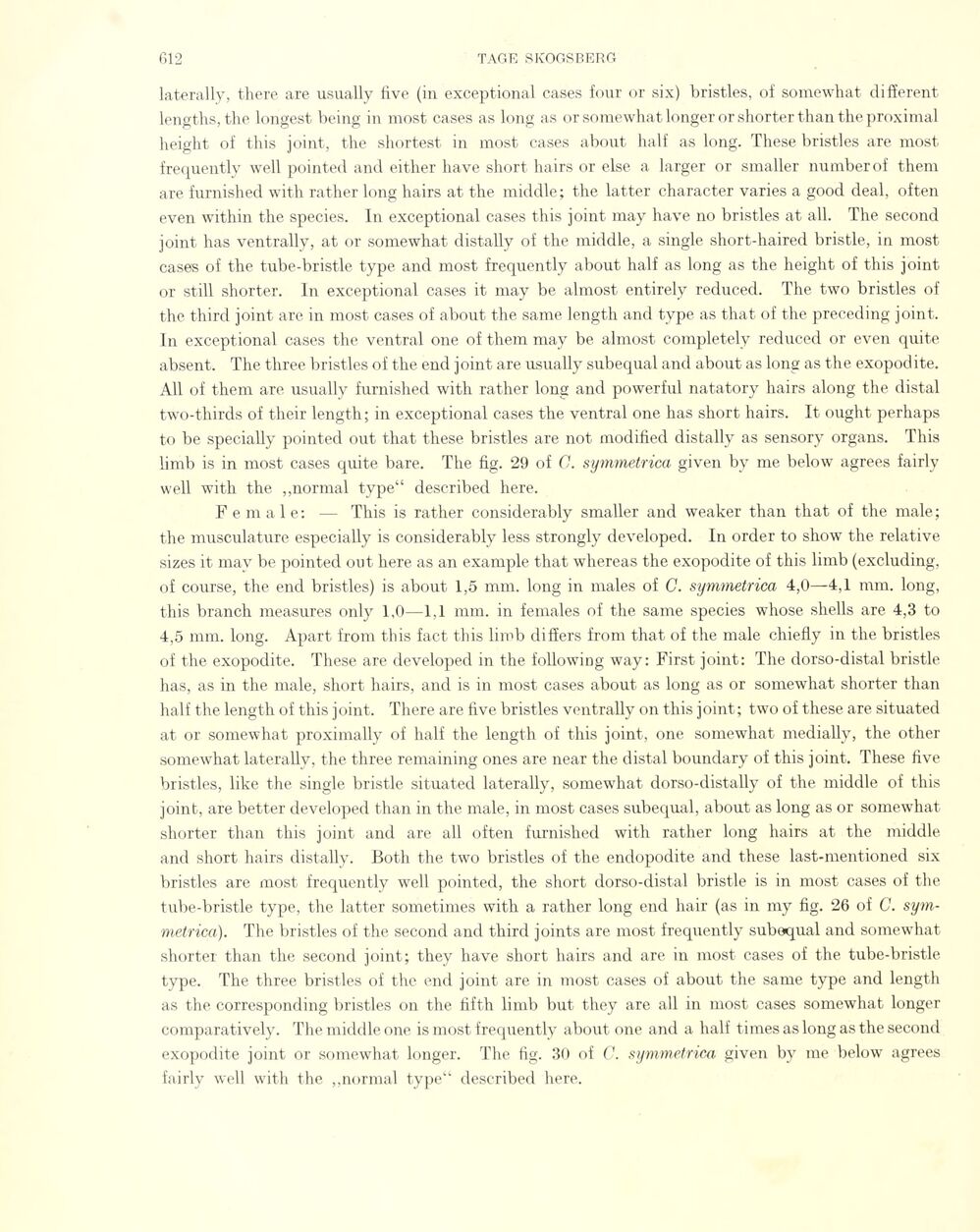
Full resolution (JPEG) - On this page / på denna sida - Sidor ...

<< prev. page << föreg. sida << >> nästa sida >> next page >>
Below is the raw OCR text
from the above scanned image.
Do you see an error? Proofread the page now!
Här nedan syns maskintolkade texten från faksimilbilden ovan.
Ser du något fel? Korrekturläs sidan nu!
This page has never been proofread. / Denna sida har aldrig korrekturlästs.
laterally, there are usually five (in exceptional cases four or six) bristles, of somewhat different
lengths, the longest being in most cases as long as or somewhat longer or shorter than the proximal
height of this joint, the shortest in most cases about half as long. These bristles are most
frei piently well pointed and either have short hairs or else a larger or smaller numberof them
are furnished with rather long hairs at the middle ; the latter character varies a good deal, often
even within the species. In exceptional cases this joint may have no bristles at all. The second
joint has ventrally, at or somewhat distally of the middle, a single short-haired bristle, in most
cases of the tube-bristle type and most frequently about half as long as the height of this joint
or still shorter. In exceptional cases it may be almost entirely reduced. The two bristles of
the third joint are in most cases of about the same length and type as that of the preceding joint.
In exceptional cases the ventral one of them may be almost completely reduced or even quite
absent. The three bristles of the end joint are usually subequal and about as long as the exopodite.
Ail of them are usually furnished with rather long and powerful natatory hairs along the distal
two-thirds of their length; in exceptional cases the ventral one has short hairs. It ought perhaps
to be specially pointed out that these bristles are not modified distally as sensory organs. This
limb is in most cases quite bare. The fig. 29 of C. symmetrica given by me below agrees fairly
well with the „normal type“ described here.
Female: — This is rather considerably smaller and weaker than that of the male;
the musculature especially is considerably less strongly developed. In order to show the relative
sizes it may be pointed out here as an example that whereas the exopodite of this limb (excluding,
of course, the end bristles) is about 1,5 mm. long in males of C. symmetrica 4,0—4,1 mm. long,
this branch measures only 1,0—1,1 mm. in females of the same species whose shells are 4,3 to
4,5 mm. long. Apart from this faet this limb differs from that of the male chiefly in the bristles
of the exopodite. These are developed in the followiug way: First joint: The dorso-distal bristle
has, as in the male, short hairs, and is in most cases about as long as or somewhat shorter than
half the length of this joint. There are live bristles ventrally on this joint; two of these are situated
at or somewhat proximally of half the length of this joint, one somewhat medially, the other
somewhat laterally, the three remaining ones are near the distal boundary of this joint. These five
bristles, like the single bristle situated laterally, somewhat dorso-distally of the middle of this
joint, are better developed than in the male, in most cases subequal, about as long as or somewhat
shorter than this joint and are all often furnished with rather long hairs at the middle
and short hairs distally. Both the two bristles of the endopodite and these last-mentioned six
bristles are most frequently well pointed, the short dorso-distal bristle is in most cases of the
tube-bristle type, the latter sometimes with a rather long end hair (as in my fig. 26 of C.
symmetrica). The bristles of the second and third joints are most frequently subequal and somewhat
shorter than the second joint; they have short hairs and are in most cases of the tube-bristle
type. The three bristles of the end joint are in most cases of about the same type and length
as the corresponding bristles on the fifth limb but they are all in most cases somewhat longer
comparatively. The middle one is most frequently about one and a half times as long as the second
exopodite joint or somewhat longer. The fig. 30 of C. symmetrica given by me below agréés
fairly well with the „normal type“ described here.
<< prev. page << föreg. sida << >> nästa sida >> next page >>